In Episode 89 our feature interview focuses on fine Shetland lace, as we speak with the Curator of the Shetland Museum and Archives, Dr Carol Christiansen. Carol is leading the Museum’s Lace Assessment Project, which aims to document a collection of around 400 pieces of hand-knitted traditional Shetland lace. It’s a fascinating project and the team have already made some interesting discoveries.
Staying in Shetland but now with more contemporary works, we are also speaking to Shetland artist, Helen Robertson. Helen learnt traditional knitting as a child, but later on experimented with materials to create jewellery
Shetland Lace with Dr Carol Christiansen
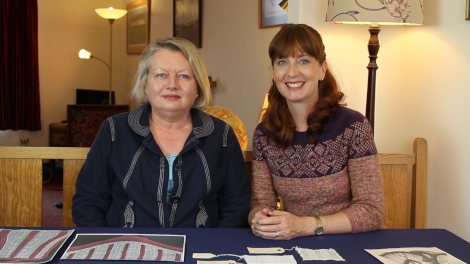
Dr. Carol Christiansen gives us a brief summary of how lace knitting developed in Shetland and then gives us an update on the Lace assessment Project. As Carol and her team have been fully assessing, recording and cataloging the Museum’s large collection of traditional Shetland Lace, they have discovered some unusual and rarely seen lace motifs and techniques.
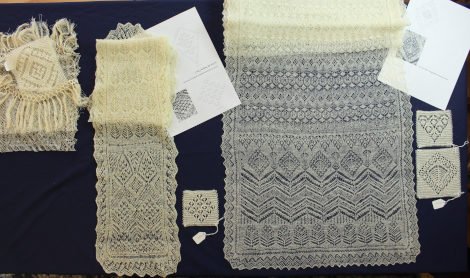
Part of their research has been to chart and rework these patterns with all their variations so that eventually they can be published in a book and made available for future hand knitters to use.

Many Shetland Lace shawls are very complex with multiple, intricate patterns included in a single shawl. Crepe Shawls are extremely simple in comparison and really show off the exception skills of the spinner. Carol also tells us about these remarkably elegant shawls.

Finding Dr. Carol Christiansen
If you would like to keep up to date with the Lace Assessment Project you can follow Dr. Carol Christiansen’s blog
Helen Robertson
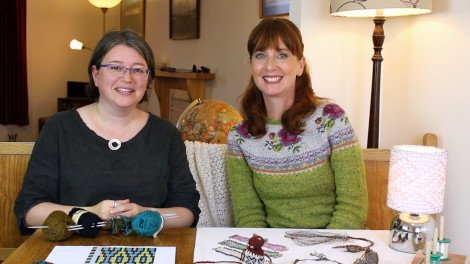
Helen Robertson is a Shetland artist who grew up surrounded by traditional lace knitting. Helen now incorporates her lace knitting heritage into her work as a textile and jewelry artist.
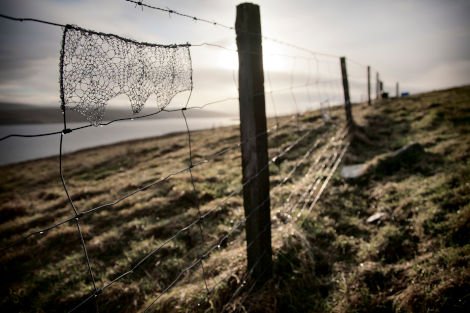
Helen feels very deeply about remembering and celebrating the personal lives of the highly skilled Shetland knitters who were often knitting the most opulent and luxurious shawls and garments while living in extreme poverty themselves. Her lace knitting installations are a tribute to their lives and stories.
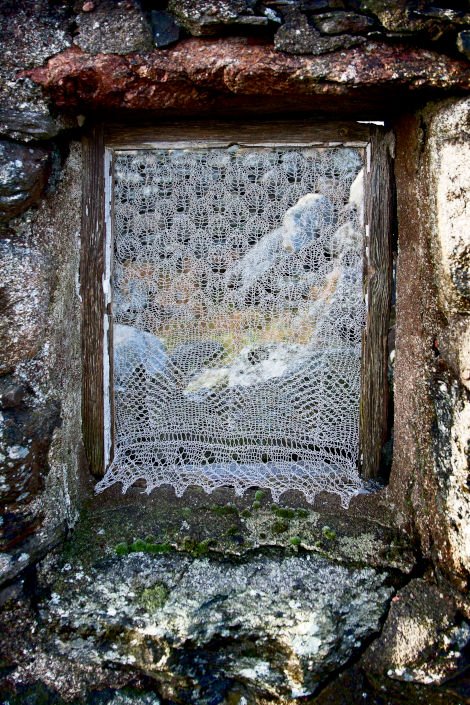
Helen was commissioned to knit wire lace lampshades for the Shetland Museum. Locally in Shetland, Fair Isle and Lace knitting was often undervalued because everyone could do it. Helen was inspired to hold Shetland lace up high and shine new light on it and bring it to a highly valued status. People literally have to look up to see her shining lace lampshades in the Museum cafe.
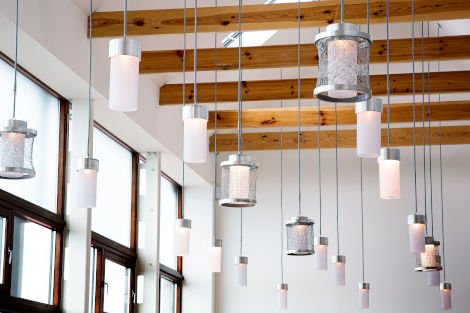
Helen makes very beautiful jewelry by hand knitting traditional Shetland lace patterns with silver wire.

Patron Discount – Helen Robertson
Helen is offering Fruity Knitting Patrons a 25% discount on her FISS cowl pattern. Helen developed the FISS (Fair Isle, Slip Stitch) technique to allow the knitter to have three colours in a row. What is so special? The knitter only ever knits with either one or two colours and slips up the third colour. Helen is developing around 50 patterns for a future book on this technique. If Patrons are interested in purchasing any of Helen’s handmade jewelry, Helen is offering free shipping.
Finding Helen Robertson
Under Construction
Bird’s Eye Swatch
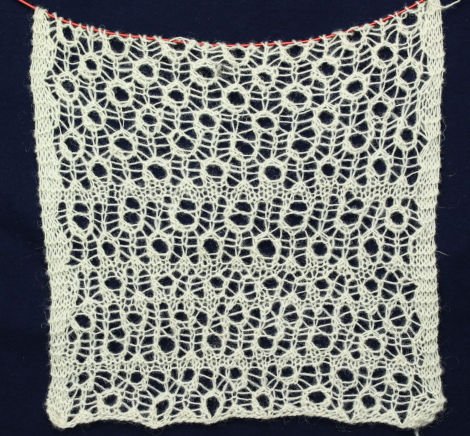
Andrew has never knitted any type of lace before but after seeing Lauren’s Anderson’s beautiful Bird’s Eye scarf in the previous episode he had a mad desire to try it. This is his swatch. His routine is to knit as far as he can and when he makes too many mistakes to fix, he knits a couple of rows of garter stitch and then starts again. He got 24 rows done in his last attempt. Lifelines annoy him and this is just a practice swatch.
Morning Star Bridal Jacket – Christel Seyfarth
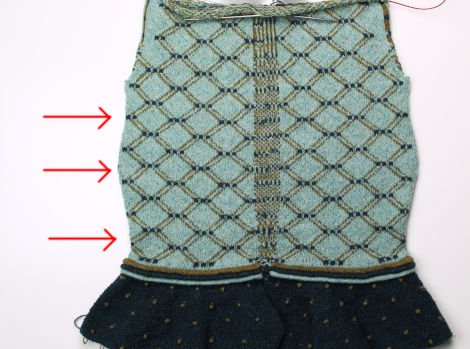
This picture shows fairly clearly the shaping that I have ended up doing. It’s all too difficult to describe here, you’ll have to watch the show!
- Morning Star Bridal Jacket – Christel Seyfarth
What we are wearing
Sitting on the couch, Andrew is wearing the Whelk vest by Martin Storey and Andrea is wearing Sculpted Frost by Linda Marveng. During the interview with Dr. Carol Christiansen Andrea is wearing Saint Lunaire Griquet by Jennifer Beale. During the interview with Helen Robertson Andrea is wearing Blossom by Marie Wallin.
Music Credits
- J. S. Bach, The Well Tempered Klavier, Prelude No. 3 in C-Sharp major, BWV 848, performed by Kimiko Ishizaka, Creative Commons Attribution 3.0
- Aleksander Scriabin, Valse, Op. 38, performed by Konstantin Semilakovs, Creative Commons Attribution-NonCommercial-NoDerivs 3.0 Unported
- Alexander Scriabin, 3 Pieces, Op. 2, No 1, Etude in C Sharp Minor, performed by Vadim Chaimovich, Creative Commons Public Domain
Image Credits
- Images of the Burnous Lace Shawl used with permission from the Shetland Museum and Archives.


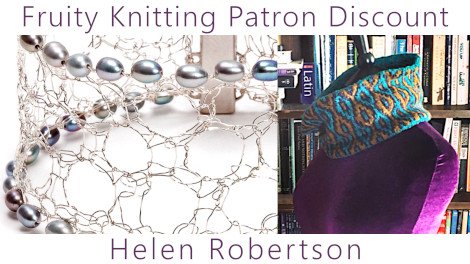

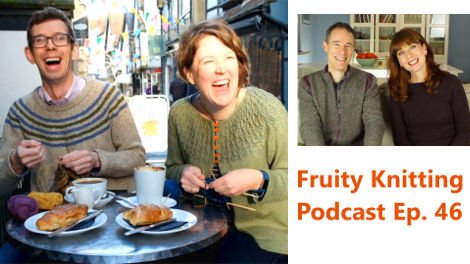
11 thoughts on “Episode 89 – Shetland Lace at its Best”
Thank you for a lovely episode that realy hits the spot for me. I love lace and have been a bobbin lace maker for nearly thirty years as well as a knitter for much longer. When it comes to lace I enjoy the history part of the project as much as the actual process of making it. I am not a prolific lace maker but do try to put something new to me, from times gone by or from another area of the world, into what ever I am making. And.. I have just been reading a book on Shetland Lace! 🙂
Hello You two
Thank you both for funny, interesting, teaching and visually beautiful podcasts, which I love being a patron to/for. I have been looking, but haven’t yet found; does some kind of index for the episode exist? All the best from Dorthe Viemose
Dorthe, thank you for your support. Two suggestions:
Both on this website.
Greetings Andrea & Andrew – I just watched episode 89… wonderful as always! Thank you. But particularly, I would like to thank for explaining about the music we were hearing in both this episode & the last one (88)… I really appreciate learning about the pieces & their composers. So thank you Andrea for sharing your musical knowledge with us! It adds such a lovely depth to your podcast.
From one of your patrons. Keep up the great work, Michele Dillon
Thank you, Michele! We do always name the music in the program notes – under Music Credits. But yes, I also like to mention the music in the show.
Don’t know if I’m doing this right. Long story short: The Bird’s Eye pattern has had me stumped for years. I recently remembered some advice regarding tough patterns: Write out the pattern, line by line, on cards. Translating the Bird’s Eye chart, line 1 reads (in my notation) “ K3, O, SK2P, O, K2 [K1, O, SK2P, O, K3, O, SK2P, O, K2] K1, O, SK2P, O, K3.” The stuff in brackets is the repeat. After writing out each line on individual cards, I noticed patterns in the pattern. That 1st line repeats O, SK2P and O, K3. Line 2 alternates O, K1, O with SSK, K1, K2tog. Line 3 has a pattern of yarn overs followed by K1 (1 st), then SSK (2 sts), then SK2P (3 sts). The remaining 5 lines of pattern uses one of these 3 sequences. The analysis has simplified the pattern and may be of use to Andrew. That’s all. Love the show.
This is my year of learning more, much more than normal and your programs play an important role. First there is my learning of sheep husbandry, then my continuation of learning about spinning, then learning more about wool preparation that comes with every new fleece, knitting is new to me and you two with help from your guests area tremendous motivationL force (Andrew especially), your choice of Bach with this episode relates to my resumption of piano lessons after a hiatus of 20 plus years, and to make sure I run out of things to learn, Monday I have my very first cello lesson! Again your choice of music will be a motivation force. Fair Island knitting is waiting to be tackled and I have Alice Starmore’s guide to halp me plus your helpful tutorials. What can I say but thank you so very much!
Did you really swear during this episode? I replayed with captions to make sure I heard that correctly, disappointing…..Wow…..
Hi Theresa. Not sure what you’re referring to. We try to keep it family friendly, but sorry if we’ve failed you.
Andrew, episode 89 at 14:15.
I do really enjoy your program. Was just very surprised.
I remember now – naughty, and got past quality control…